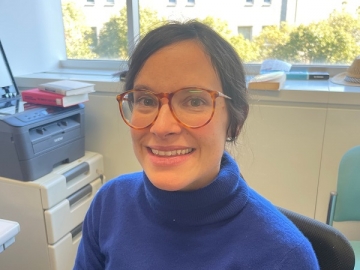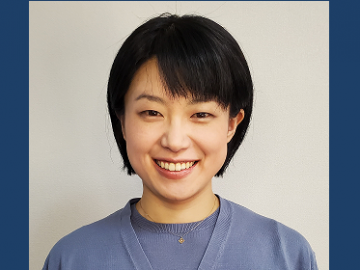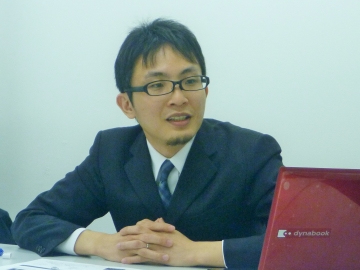
- Daisuke Yamamoto, Assistant Professor (April, 2015)
Quantum mechanics lie behind the properties exhibited by matter
The academic field engaged in research on the properties exhibited outwardly by matter (physical properties) and the microscopic mechanisms that give rise to those properties is known as “solid state physics” or “condensed matter physics”. Such properties of matter that are the subjects of frequent study include electrical properties (whether electricity is conducted or not), magnetic properties (whether characteristics of a magnet are shown or not), and optical properties (whether light is absorbed or discharged).
Researchers in the field of solid state physics can be divided into experimentalists and theorists. Experimentalists synthesize various types of matter and measure their physical properties, while theorists devise theories to explain the mechanisms that are the foundation of those physical properties, and create mathematical models for them. For example, the phenomenon of superconductivity, where the electrical resistivity of a substance becomes zero when its temperature falls below a certain point, was described by a model suggested by 3 researchers including John Bardeen in 1957. However, this model is not able to fully explain the phenomenon of the so-called high-temperature superconductivity which was discovered in 1986, leaving the challenge open for theorists to pursue.
Not only superconductivity, but all types of physical properties are produced by the collective behavior of the enormous quantities of atoms and electrons (a magnitude of 10 to the 23rd power) that exist within matter and possess some interactions with each other. As a theorist in this field, I am involved in research studies to explain physical properties based on quantum mechanics and statistical mechanics.
Deciphering the origins of physical phenomena with a pen, notebook, and computer
Unlike experimentalists, theorists perform their studies with numerical calculations using pens, notebooks, and computers. When trying to explain a certain phenomenon, formulas that express the phenomenon can initially be guided by physical laws, but solving a formula in terms of a tremendous quantity of atoms or electrons is, in principle, impossible. This is where various types of approximation techniques are developed and come into play.
In my case, I first decide on a phenomenon I would like to explain theoretically from among those which I have a personal interest in. I express that phenomenon using a formula, and while keeping the important physics-related components intact as much as possible, I attempt to manipulate the formula into a form that can be solved. To do this, I select the best technique from among existing ones and modify it as required, and if I reach the limits of the scope of the existing technique, I develop a new one. This is extremely rigorous work but it is the stance I take and strictly adhere to when working on my research. Once I have succeeded in manipulating the formula into a solvable form, I calculate it using a computer and obtain its results.
Unraveling the mystery of frustration of triangular lattice spins
Allow me to introduce one example of my research. I recently engaged in a theoretical study involving a problem known as “frustrated magnetism”. Electrons, which are among the atoms that make up matter, have what is known as a spin, which is like a small magnet generated by a property of electrons similar to rotation, and when these minute magnets are assembled together in enormous quantities, they determine the magnetic properties of matter.
When these spins have the nature of tending to arrange themselves in an alternating pattern, if the atoms align in the form of a square lattice, the spins alternately face in opposite directions and therefore reach a stable condition. In the case of a triangular lattice, however, as shown in the left image of Figure 1, it is believed that the spins align with an angle of 120° relative to each other and stabilize in this arrangement. Now, if a magnetic field is applied to the triangular lattice, which causes all of the spins to reorient themselves to face the magnetic-field direction, how do the directions of the spins change (what kind of magnetization processes do they undergo) until they reach a “saturation state” as shown in the right side of Figure 1? In the scope of classical mechanics, a myriad of possible solutions to this question were actually considered, and since the energy value does not change no matter what path is taken, it falls into a state of frustration where none of the path is conclusively determined.
However, when the quantum mechanics starts playing a role, the state of frustration is broken by the quantum effects, and a single stable magnetization process is determined. Using a technique known as the cluster mean-field theory, I derived the answer to how the directions of these spins, considered in sets of 3 (red arrows in Figure 1), change as the applied magnetic field becomes stronger.
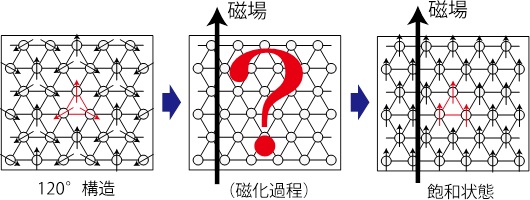
Figure 1: Directions of spins in a triangular lattice. Although it is generally believed that the spins are stable with an angle of 120°between them (left), if a magnetic field is applied, what kind of magnetization processes do they undergo until they reach a state where they are aligned in the magnetic-field direction (right)?
So then, were the results of my calculations correct? To clearly determine this, it was necessary to conduct experiments on matter in which spins existed in a triangular lattice. Fortunately for me, a group including Professor Hidekazu Tanaka of the Tokyo Institute of Technology, and Koichi Kindo of The University of Tokyo had succeeded in synthesizing a substance known as Ba3CoSb2O9 at this time (Figure 2). This is a substance which contains magnetic Co2+ ions aligned into triangular lattices, stacked in multiple layers.
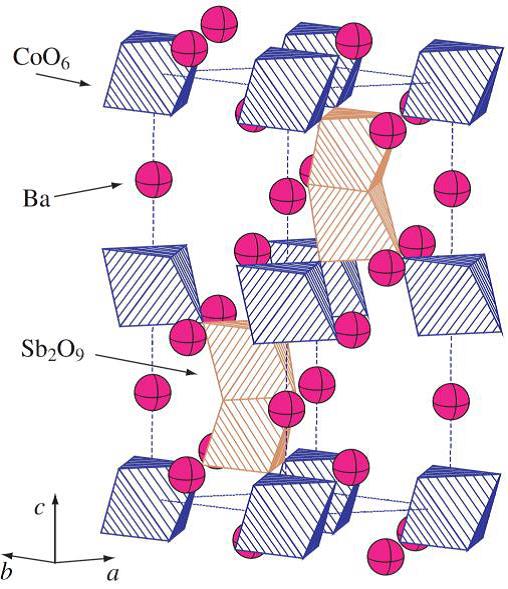
Figure 2: Structure of Ba3CoSb2O9. The Co spins form a triangular lattice. The Ba and Sb2O9 act to pull apart the planes of the Co triangular lattice.
Reprinted with permission from http://dx.doi.org/10.1103/PhysRevLett.108.057205 Copyright (2012) by the American Physical Society
Professors Tanaka and Kindo and their team applied a strong pulsed magnetic field to this sample, and precisely measured the strength of the magnetism that was generated (magnetization). The results showed that the behavior of the subsequent magnetism was highly consistent with the graph that I had derived theoretically (Figure 3). A particularly important point was that there was a peak around the region where the magnetic field value was 3. The strength of the magnetic field at this time corresponds to roughly 70% of the saturation state (which is around the value 4.5) where all of the spins face in the same direction as the magnetic field. This type of peak structure had not been predicted in most of the theories up until this point. My theory was able to reproduce the experiment with an extremely high level of agreement, and identified that this peak was generated by the mutual interaction between the spins existing in the layer being considered with those of the layers above and below it. These findings were published in the January 16, 2015 edition of the US academic journal “Physical Review Letters”.
The results obtained from this experiment indicate that my proposed theory is accurate, and also that the sample produced by Professors Tanaka and Kindo and their team is an ideal substance that follows the applicable theories.
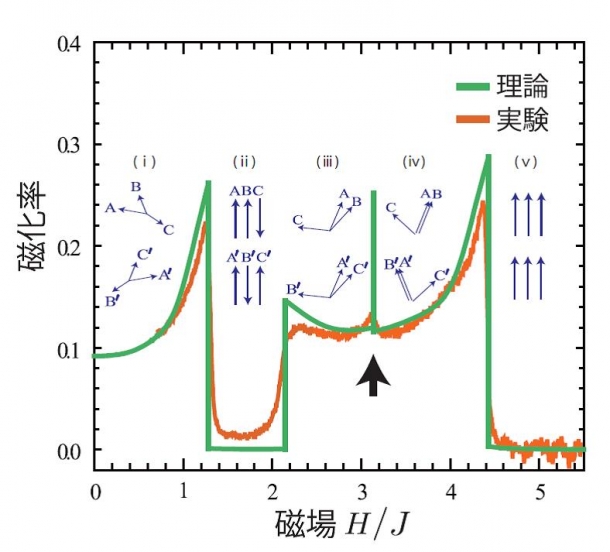
Figure 3: Assistant Professor Yamamoto calculated how the directions of spins in sets of 3 change depending on the strength of a magnetic field. Items (i) to (v) show the changes undergone by spins in sets of 3 (for 2 layers, upper and lower). This graph expresses the rate of change of magnetization (total of vectors of 3 spins added together), or magnetic susceptibility, and closely agrees with the measured values obtained from experiments. When the spins change direction (meaning that phase transitions are occurring), there are large changes shown in the graph. In particular, the peak appearing around the region of magnetic field value 3 is due to phase transitions between (iii) and (iv), which were not predicted by theoretical calculations in the past, but were accurately predicted by Assistant Professor Yamamoto.
My desire is to contribute to the advancement of physics
While proceeding with my theoretical calculations this time, experimental results were announced for a substance with conditions that almost exactly fit my theory, and so the degree of agreement between the theory and the experimental results could be quickly confirmed. There are on occasion cases like this where a theory is able to accurately explain a physical phenomenon, but conversely there are also cases where theorists might predict an interesting phenomenon that has not yet been actualized with the current techniques. Such cases pose great challenges for theorists, but if experimentalists have enough of an interest in those predictions, they may be able to devise substances or measurement techniques able to realize the predicted phenomena.
I originally began doing research with the idea of thoroughly investigating the foundations of physics and the essence of matter. Unraveling the mysteries of fundamental physics can fill in the gaps still remaining in the physics field and add new pages to our textbooks. Furthermore, accumulating advanced knowledge related to physical properties will also likely lead to the development of practical applications in the future. From here on as well, I would like to continue my research, driven by the desire to always know more, and to contribute to the advancement of the physics field.
Interview and composition: Seiko Aoyama / Akiko Ikeda
In cooperation with: Waseda University Graduate School of Political Science J-School

